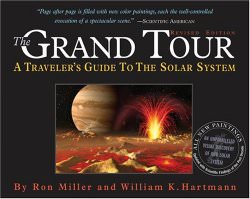
Our solar system rates little more than an acknowledgement from the average person. Simple rhymes from grade school help us memorize the planet names and their order from closest to the Sun to farthest out. As the solar system changes ever so slightly in the brevity of the average person’s life, this is reasonable. However, we have been lucky enough to have recently seen the bright comets Halley and Hale-Bopp trek by the sun. Then comet Shoemaker-Levy 9 disintegrated and slammed into Jupiter. In keeping with this awakening interest, we routinely scan the skies for asteroids that might impact our Earth. With all this activity, it becomes obvious our solar system is anything but routine. Hence, a travel guide is an excellent resource for learning more.
Miller and Hartmann’s tour book is a great complement for those wanting to know more about the worlds circling our Sun. Using the tools of artists, together with the concise detailing of science, the far away worlds come alive before our eyes. Distinct chapters highlight individual planets and the smaller worlds. The presentation stresses a view as if for a visitor rather than an occupant of Earth. In following this vein, the authors start with the largest planet, Jupiter. A fairly regular description then ensues. The atmosphere, its properties and constituent matter get appraised. The surface shape, colour, and any novel features characterize the world. Then last, the interior gets mentioned often as a tie-in to the formation process of the solar system. Understandably, the authors have to rely on knowledge gained from probes sent and surveys undertaken by humankind, so the details of Venus, Earth and Mars are lengthy while many others are quite short and rather impersonal. For instance, Asteroid 6178 gets a two page entry, principally due to it being a pure nickel-iron alloy. But it and manner others do get mentioned.
Setting this book apart from your garden variety tour guide are the graphics and images. Hundreds of large and small coloured plates place the reader directly at the subject’s location. There’s one as if the viewer is standing in the middle of Saturn’s ring watching hundreds of fellow ring objects dance along. Or picture yourself on one lobe of the compound asteroid 624 Hektor looking down at a strange connecting valley and on up to the next lobe. Many images are grand vistas where the viewer is on an orbiting world with a planet filling the distance. For example there’s the cliff of Miranda while the ring system of Uranus defines a blue back drop. With accurate angles and perspectives it is often difficult to separate the computer drawn images to real photographs. Nevertheless, with this book in hand, all you need is a vehicle and you’d be off wandering to your favourite.
The format of the book (long rather than tall) further enhances these images, as many two paged vistas are quite breathtaking. These and the complementary text keep the reader pressing forward to find more wondrous natural sights of space. Further, even though this is the third edition, the images and data aren’t dated, as much information is recent. And don’t let the 3D hologram on the front cover make you think this book is purely for children. The detail and presentation is much more apropos for secondary school students or the beginning space buff. However, given the strength of the artwork, I was disappointed at the brevity of the section for worlds Beyond Our Solar System. There would be little to lose and, I think, much to gain from letting learned imaginations fill wide vistas of planets in other solar systems.
Our solar system keeps our special planet Earth in just the right location to allow our own happy lives. This doesn’t, however, bind us to this paradise. Other exciting, unique and pictorially sensational worlds grace our passage about our Sun. So read Ron Miller and William K. Hartmann’s book The Grand Tour, A Traveler’s Guide to the Solar System and get acquainted or re-acquainted with the beauty and relevance of these other worlds that share our immediate space.
Review by Mark Mortimer
Read more reviews online, or purchase a copy from Amazon.com.
